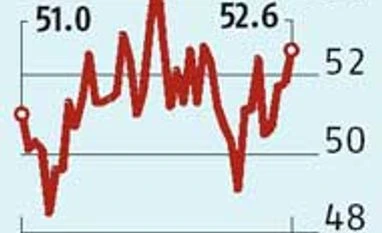India’s manufacturing activity grew at the fastest clip in 13 months in August, backed by a surge in new orders and output, according to the widely-tracked Nikkei purchasing managers’ index (PMI) survey. Even then, only marginal additional employment was generated by manufacturers.
PMI rose to 52.6 in August, from July’s 51.8, which was an eighth straight month of expansion, indicating positive momentum in the production sector. The 50-point mark separates expansion from contraction.
In official data as well, it was primarily manufacturing activity, which among a few other segments, such as electricity and government expenditure, were outliers in an otherwise dismal gross domestic product growth of 7.1 per cent in the first quarter of 2016-17, a five-quarter low. Manufacturing expanded 9.1 per cent. IHS Markit, which compiles data for PMI, expects India’s economy to grow 7.5 per cent in the current financial year, slightly lower than 7.6 per cent recorded in the previous year and substantially less than the government’s expectations of close to eight per cent.
PMI rose to 52.6 in August, from July’s 51.8, which was an eighth straight month of expansion, indicating positive momentum in the production sector. The 50-point mark separates expansion from contraction.
In official data as well, it was primarily manufacturing activity, which among a few other segments, such as electricity and government expenditure, were outliers in an otherwise dismal gross domestic product growth of 7.1 per cent in the first quarter of 2016-17, a five-quarter low. Manufacturing expanded 9.1 per cent. IHS Markit, which compiles data for PMI, expects India’s economy to grow 7.5 per cent in the current financial year, slightly lower than 7.6 per cent recorded in the previous year and substantially less than the government’s expectations of close to eight per cent.
“Manufacturing PMI data show that the positive momentum seen at the beginning of the second semester has been carried over into August, with expansion rates for new work, buying levels and production accelerating further,” said Pollyanna De Lima, economist at IHS Markit.
According to the PMI report, based on survey of 500 private sector companies, new export orders expanded at the quickest rate in one year. August saw a sharp upturn in new business inflows, which expanded at the quickest pace since December 2014. Consumer goods producers led the increase and strong growth was also seen in the intermediate and capital goods categories. However, capital goods production contracted for eight months on the trot in the official Index of Industrial Production. Also, gross fixed capital formation contracted three per cent in the first quarter of FY17, a second quarterly straight fall. Subsequently, companies continued to raise output in August, with growth picking up to the strongest in one year. Price pressure eased, with raw material costs increasing at their weakest rate in six months and output prices barely rising, suggesting consumer inflation could cool in the coming months.
“In light of these numbers, the RBI has scope to loosen monetary policy in the upcoming meeting to further support economic growth in India,” De Lima said.
The repo rate stands at 6.5 per cent. Retail inflation in India was 6.07 per cent in July, above the new target of keeping inflation in the range of two to six per cent.
Greater output requirements led some manufacturers to hire additional workers in August, but the overall rate of job creation remained marginal, as the vast majority of firms left workforce numbers unchanged.
)